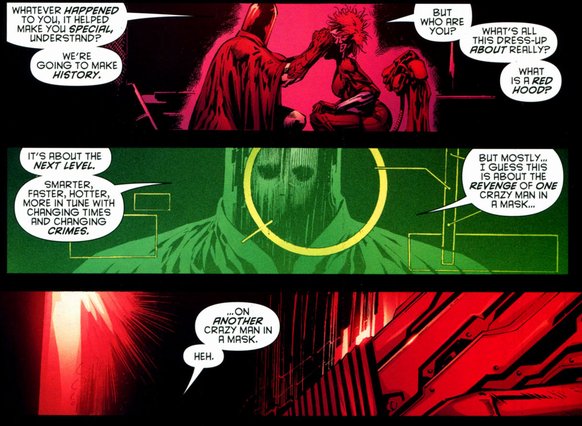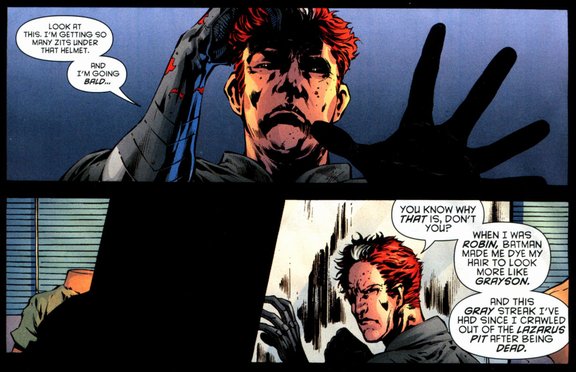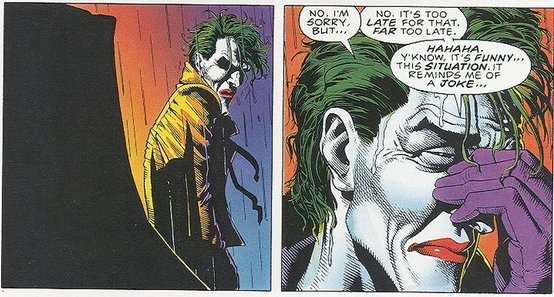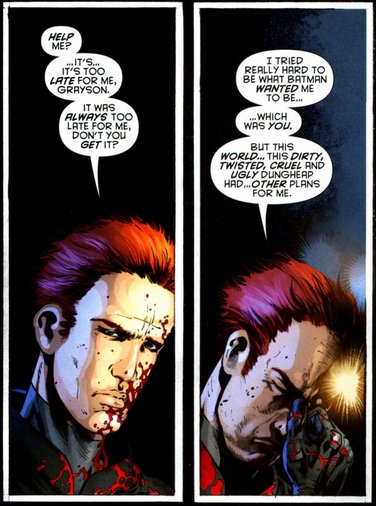
Batman & Robin & The Facets of the Joker
November 15th, 2009 by Gavok | Tags: alan moore, Batman, batman and robin, damian wayne, DC comics, dick grayson, grant morrison, jason todd, joker, professor pyg, red hood, robinEarlier today I put up another edition of This Week in Panels. When I was getting the one for Batman and Robin #6, I noticed something odd. A striking similarity that didn’t poke out the first time I read it. At first I was wondering if it was a coincidence, but then I looked further into it and noticed that there were even more similarities. Being that this is Grant Morrison, I knew all of these nods had to be intentional.
One of the things about Dick Grayson as Batman is that he needs his own villain. Yes, he can fight the Joker, but it wouldn’t be the same. They wouldn’t have the magic of Bruce and the Joker as rivals. On the other hand, there’s Jason Todd. Ever since he’s been brought back to life, he’s been wasted potential. Whether he’s Red Hood, Nightwing, Red Robin or Batman with guns, he’s been in one bad story after another. And while Bruce Jones’ horrible Nightwing squandered Dick vs. Jason, the potential is still there. Dick Grayson and Jason Todd are meant to be archenemies. Todd would play off Dick far better than he would Bruce.

So if Jason Todd is Dick Grayson’s Joker, then they need to cement this. Most would consider Alan Moore and Brian Bolland’s Killing Joke to be the ultimate Batman vs. Joker story. It’s fitting that the first six issues of Batman and Robin have been something of a retelling of that very story. Let’s look at the two:
We begin with the first three issues with art done by Frank Quitely. The first link is a weak one, I admit. In Killing Joke, Alfred walks in on an unmasked Batman, who mulls over how there’s absolutely zero data out there on who the Joker is. Alfred gives him his dinner and when asked if he needs help, Bruce remarks, “No. That’s all.”
Alfred gets the same blunt reaction from Damian Wayne, though Dick is far more accepting of the service, showing the difference between Batmen. Dick is also unmasked in his Batman garb, frustrated over his inability to find any information on the villain Mister Toad.

Professor Pyg has his own gang of carnival freaks, much like Joker did during Killing Joke. It’s definitely no mere coincidence, as Pyg’s base of operations is the same abandoned circus as the one used in that story.
Pyg shows more similarities to the Joker. In his introduction scene, we see a father and daughter in an apartment. As they go to open the door, expecting someone else, they instead find Pyg and his gang of goons, reminiscent of Joker and his goons barging in on the Gordons. It’s reversed here, as Pyg assaults and physically messes up the father, and the daughter Sasha is left to see the effects and be affected mentally. Like with Joker’s plan, this is all Pyg’s way to make someone in his image. In fact, they literally say Pyg is trying to spread his “sickness”.
Pyg gets Robin as a captive and proceeds to rant and rave like a lunatic and shows him creepy imagery, again, in preparation to make another like himself. Robin, like Gordon, is rescued when Batman drives onto the scene and later breaks through the wall to get the bad guy.
That brings us to the second half of Morrison’s run so far, featuring the art of Philip Tan. The main antagonist here is Jason Todd, having returned to his Red Hood persona. Again, this parallels with Killing Joke, which showed Joker committing crimes under the same gimmick. As an aside, Red Hood’s appearance is based on Red Mask, a character from Morrison’s Animal Man. That has no bearing on anything, but it’s a neat reference.
The similarities begin with Red Hood’s first act. The only trace Batman has to go on is a calling card.

I’ll talk more about Scarlet later.
On a rooftop with Robin, Batman takes Damian’s hood and pulls it down over his face, warning him that a hood can become a blindfold. One of the reasons the Red Hood became the Joker in Killing Joke is because he couldn’t see in his helmet.
Back to Jason, his big plot has very little to do with killing Batman. He and the Joker are more out to prove a point more than anything else. He’s trying to prove the inner-workings of the average human being.
There were even suggestions after Batman and Robin #4 came out that Red Hood wasn’t Jason in this story, but Joker himself. #5 showed the truth through and unmasking and some rather interesting dialogue.

It continues. Joker’s skin and hair were messed up thanks to the original Batman. Jason’s skin and hair were messed up thanks to the current Batman. Not only that, but his hair was further altered by being thrown into a pit of chemicals.
Eduardo Flamingo shows up. If anything, he shares many basic similarities with the Joker: His frame, his head shape, his showmanship and his laughter. Other than grunts, all he communicates with is simply laughter. Scarlet carves up his face at one point and although we can’t see the aftermath, we can figure that the scar is very much like the Heath Ledger Joker smile. There’s even a silhouette shot of him laughing maniacally, which makes him look like a dead ringer for the 90’s cartoon Joker.
Batman and Robin are defeated by Red Hood. He proceeds to strip them down, tie them up and sets up a public relations deathtrap. He puts them on camera and tells the people watching to call a certain phone number if they agree with his stance on killing. If they get a million calls, the camera will show Batman and Robin in their underwear. This is interesting for two reasons. First, it’s a play on the circumstances of Jason’s death. Remember, he got killed by the fans via a hotline.
Second, there’s another Joker similarity. Joker stripped down Barbara Gordon and took pictures of her as part of his scheme. Jason has also taken off their clothes in an attempt to film them.
Speaking of Barbara, the big thing of Killing Joke was how she was shot in the spine and crippled for life. Flamingo does the same to Robin, but thanks to Talia’s resources, it won’t be as permanent.
The dénouement is what made me realize this whole thing in the first place. Batman has Jason cornered. Rather than continue the fight, he expresses that he wants to put this all behind them. He wants to help him. For a second, Jason almost considers it, but he can’t.


The world has already pushed him too far towards his destination. There is no turning back. In his defeated speech about how things are always going to be, the police arrive to take him away. Jason remarks that he’s done what Batman couldn’t do, which is defeat his archenemy by murdering Flamingo. Does he define his archenemy as Flamingo or Dick Grayson himself? That’s up to us to decide.
Now back to Scarlet. It would be easy to have her represent Barbara Gordon in all of this, considering she’s the only major female character and a young one at that. Instead, she represents Jim Gordon. To Pyg, she’s a guinea pig there to make in his image. To Jason, she’s a kindred spirit and a way to show that he’s not alone in who he is and how he came to be.
Yet, in the end, she proves them both wrong. She leaves Gotham and her fake face finally comes off. Though shaken up by the events, she’s able to live her own life as her own person. She and Jim Gordon defy their stories’ respective villains in ways the two Batmen could not.
When the Black Glove arc came out, featuring the international Batmen taking part in a murder mystery, missed 4th Letter writer Hoatzin wrote up a fantastic take on how each of those Batmen represented a different piece of the whole. In Batman and Robin, I’m starting to think that Morrison is going in the same direction, but this time for the Joker. Each villain is a piece of him.
Mr. Toad: The daredevil without any qualms of throwing caution to the wind.
Professor Pyg: The mentally-ill expert at crude science.
Flamingo: Flamboyant and cruel.
Jason Todd: Batman’s rival.
It works out well. The tragedy of Batman and the Joker is that if it wasn’t for fate’s cruel hand, these two enemies could have been good friends. With Dick and Jason, it’s possibly worse. They should have been brothers.
Thanks to David Uzumeri and DanteDyas for assistance.

Now if only Brian Bolland were drawing it instead of this Tan character…
*Achem*
http://www.bleedingcool.com/2009/09/06/is-this-the-greatest-swipe-file-of-all-time/
I wouldn’t put Mr. Toad on the same level as Professor Pyg, Toad is just another toadie *lol* who knows he can only be stopped by a super hero in a city where Batman is supposedly dead.
Excellent analysis. Nice to know there are things going on that I didn’t see the first time.
Man, not only are you the king of funny panel edits and BSS posts, but you also rule dominion over storyline analysis and comparison/contrast. With such powers combined, you could be the next Twitter superstar. I’d follow you, anyway.
so I take it I’m the only person on god’s green earth that not only thought Under the Hood was readable, but good and the only instance the revived Jason was used well? bah
in any case, good article. well thought out and an interesting read.
also surprised you didn’t note that unmasked Jason looks very similar to Walter Kovacs.
o hey triple post.
anyways on that last bit, my personal theory is that if in the build up to RIP, Hurt was trying to recreate Batman, now he’s trying to recreate Joker, which would fit perfectly with your idea. Also Pyg’s entire speech was about him undergoing torture similar to Harry Harlow’s monkey experiments of the 60’s and that led to him becoming crazy, and Flamingo was labotomized.
The moment when “Batman takes Damian’s hood and pulls it down over his face” seems like a more direct response to the scene in Miller and Lee’s All-Star Batman and Robin when Batman pulls Dick’s hood over his face. So far as I can recall, there’s no other comics antecedent for a Robin wearing a hood.
Morrison is apparently not only playing with the whole long history of Batman and Robin comics, but also offering direct responses to the Batman stories of the field’s most prominent comics creators.
@J. L. Bell: Or merely attempting to fix what he perceives as problems caused by those creators (hence writing a three-issue arc about Jason Todd). Damian is really the personification of the ‘Dark’ 90s-era Batman, a whining, spoiled, over-violent child who acts like he knows everything and pretends not be hurt when shot point-blank in the spine. What better way to get back at Miller than through the poster child for the movement he caused?
@burts: Toad definitely isn’t on Pyg’s level (especially since he’s already dead and Pyg’s still committing crimes in the future), but the way he excitedly accepts his own death in the beginning of the first issue gave me a big Joker vibe.
@Stig: which is hilarious because all he ever talks about is how much he hated the dark era of the 90’s and all their grim and gritty heroes. and he keeps on writting what he writes.
but that’s Miller for you
@Nathan: I’m starting to get tired of the various Miller defenders saying it’s all self-parody. Really, like Loeb, he’s realised that he’s too old and too rich for them to get rid of, so he can pull any shit he likes and they’ll publish it.
@Stig: I still don’t get why Miller is at fault for the ’90s grim & gritty, when he wrote one (very good) comic that was grim, a couple that were origin stories, and then spent the rest of his time doing his own work for a non-tights and fights company. Other than 1993 and that weird Spawn bit, did Miller even do any capes work?
Why not blame the writers, artists, and editors who didn’t get what he was doing? Chuck Dixon, Scott Lobdell, whoever else made it a habit of heaping tragedy upon atrocity and making comics ugly?
And give me a guy willing to pull things over a dude wanting to toe the company line any day. Those guys make interesting comics. The other people just make comics.
@Stig: I never said it was self parody, the man is fucking nuts. I’m just saying Miller is weird in that he does the opposite of what he says.
@J. L. Bell: Batman pulls Dick’s hood over his face
I laughed.
@Nathan: I was just moving to a different aspect of the subject.
@Stig: ah. my bad
I’ve always wanted a solid Jason Todd storyline, and this analysis shows me that not all hope is lost yet. Personally I was hoping he’d stay a Challenger with Donna and Kyle: think they’d have a lot to play off of. Still, maybe this latest storyline about him being a redhead (hey, the red-headed stepchild of the Batfamily) might work.
@Psychoblue: meh I still stand Winick on JT. In his run Jason actually seemed to have some semblence of a brain from issue to issue and had a tangible MO
@david brothers: Yeah, the problem with the 90s wasn’t DKR and Watchmen, it was creators thinking that crudely sewing on the superficial tropes of those seminal works to the aging form of the Superhero story would somehow invigorate it.
In the late 80s and 90s, Marvel and DC decided “people want dark superhero comics” because it was easier than taking the real lesson, which is “people want well-crafted superhero comics”.
@Nathan:
I dug “Under the Hood,” too, FWIW.
Gavok, those are some impressive cues you picked up on.
I’d give props to Morrison for them if they’d been in a story I enjoyed. Since I didn’t, it’s hard not to blame that lack of quality on his being distracted and obsessed by the past.
In Batman and Robin, I’m starting to think that Morrison is going in the same direction, but this time for the Joker. Each villain is a piece of him.
Exactly! I think Batman and Robin is as much of a Joker story as New X-Men was a Magneto story. Pyg’s circus and the Red Hood were what tipped me off, but your analysis uncovers much more.
my personal theory is that if in the build up to RIP, Hurt was trying to recreate Batman, now he’s trying to recreate Joker, which would fit perfectly with your idea.
An interesting theory indeed. After all, we haven’t seen the Joker since Damian literally bumped him off. If Hurt hasn’t either, then he may think the Joker’s dead.
Although I wonder if Batman’s “rebirth” was intentional on Hurt’s part…
Why not blame the writers, artists, and editors who didn’t get what he was doing? Chuck Dixon, Scott Lobdell, whoever else made it a habit of heaping tragedy upon atrocity and making comics ugly?
Dixon too? I honestly don’t see his 90s work as that “grim ‘n gritty” (save “Knightfall” and the Bat-crossovers). I could see why someone might say that about some of his Batman stories, but his work on Robin, Nightwing and Birds of Prey had plenty of moments of levity. In fact, he even “rescued” two characters who’d taken bad hits from “grim ‘n gritty” stories: Oracle and Black Canary.
Woops, didn’t finish a paragraph. I meant to say, “If Hurt hasn’t [seen him] either, then he may think the Joker’s dead. Which would explain why he’s trying to recreate him.”
“In fact, he even “rescued” two characters who’d taken bad hits from “grim ‘n gritty” stories: Oracle and Black Canary.”
Wasn’t it Ostrander who saved Oracle?
I’d say it was him, Kim Yale and Dixon. Ostrander and Yale established Oracle, Dixon brought Barbara back to prominence. Actually, Grant Morrison probably deserves credit too, since he brought her into the JLA.
@Gokitalo: Yeah, in hindsight, Dixon probably wasn’t the best choice. I’m thinking more of the Batman: Fugitive stuff, where Batman pushed away his friends, etc etc. I think Dixon had been removed from the books by then?
And yeah, Grant Morrison actually used Babs very well. I like that he took her from being a Gotham information broker to being a worldwide asset. Brilliant move.
[…] because the issue seemed rather sparse to me and partly because Gavok over at 4thletter! just completely demolished the landscape of any of my commentary, so what’s below regarding that issue is heavily […]
I agree with this – I kind of caught from the beginning that Morrison might think gearing Jason Todd toward being Dick Grayson’s ultimate rival would be the strongest possible direction he could move Jason in. And I feel that him having his own costume inspired by the “two men who made him – both Batman AND Joker (Red Hood)” was another part of that.
But I’ll do you one better. While Morrison is using these characters in B&R as “aspects” of the Joker … he’s been doing it all along. The Club of Villains? They are literally all inspired by Joker in the same way that the Club of Heroes are all inspired by Batman. “Le Bossu” even admits it.
Le Bossu represents Joker’s deformity and showmanship.
Pierrot Lunaire represents the creepy clown factor.
Scorpiana represents his use of chemicals and poison.
El Sombrero represents the “master of death-trap/fun house” things.
Charlie Caligula represents the depravity.
King Kraken … well, crap, I don’t know what King Kraken represents.
Morrison has been seeding the idea that like how there are those inspired by Batman, all along, parallel to that there are those inspired by Joker.
Now? The most recent? I think the Pearly King of Crime showed some clear similarities to The Joker … and I think one of the throwaway names in the Tower of London dungeons – the Welsh “Dai Laffyn” was yet another Joker devotee.
One last one.
“The Swagman”, enemy of Dark Ranger? Represents Joker as “the outlaw”. But better still, he wears the traditional gear of Ned Kelly. And who played Ned Kelly in the 2005/6/7 film of the same name?
Heath mother-frigging Ledger.
@RetroWarbird: Good catch! I was wondering about the Australian guy myself.
And in the song Waltzing Matilda, he’s called the “Jolly” Swagman, which is a Joker-ish adjective.